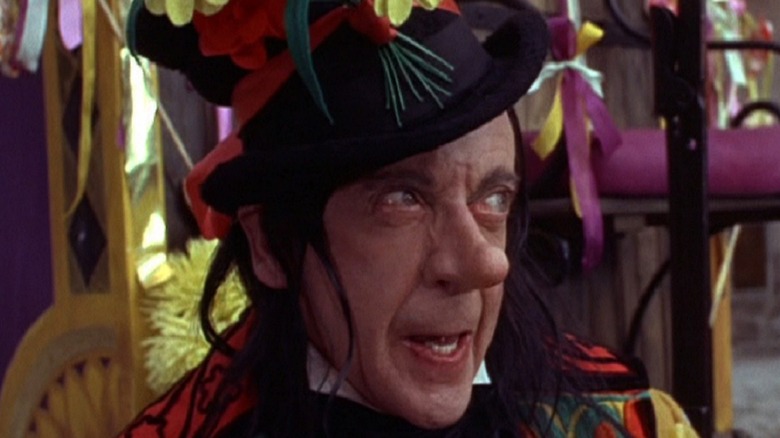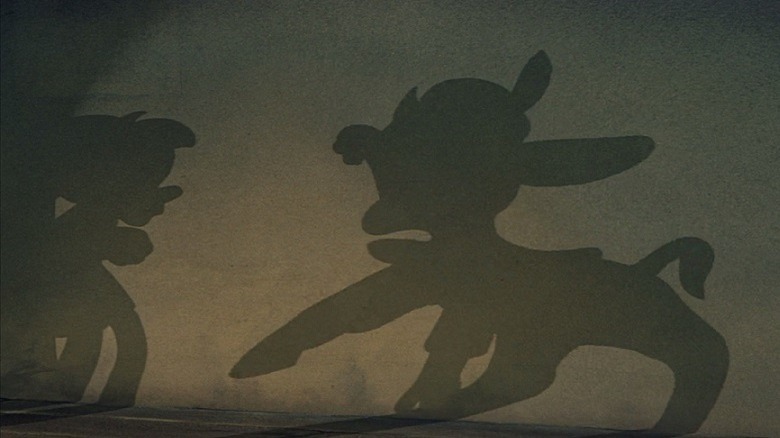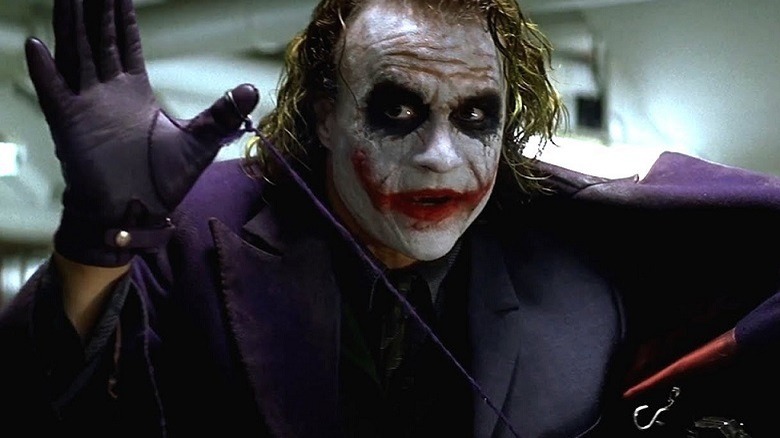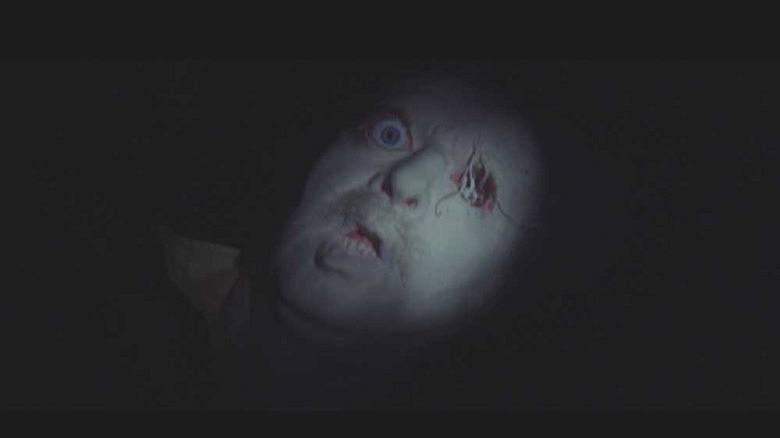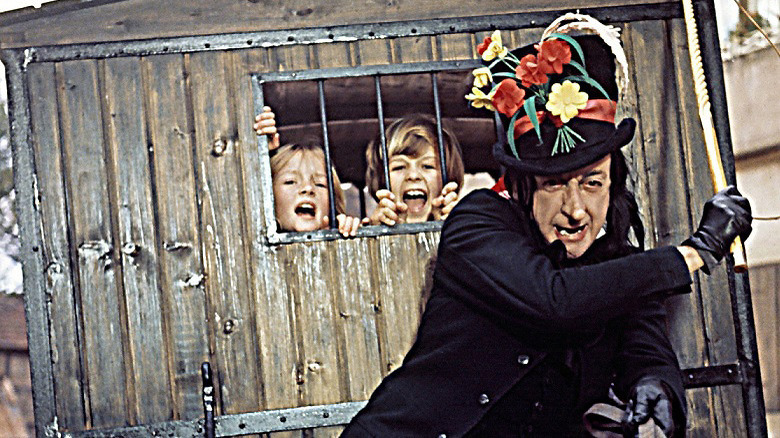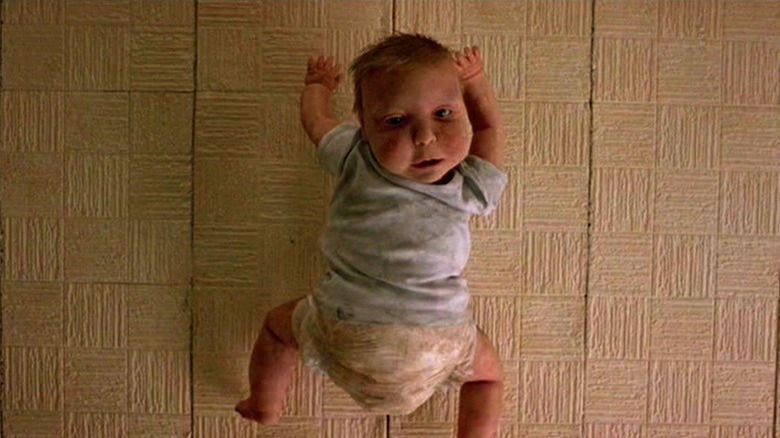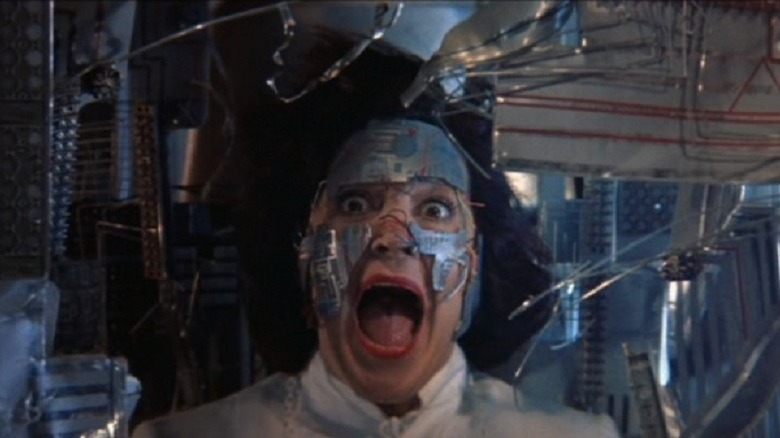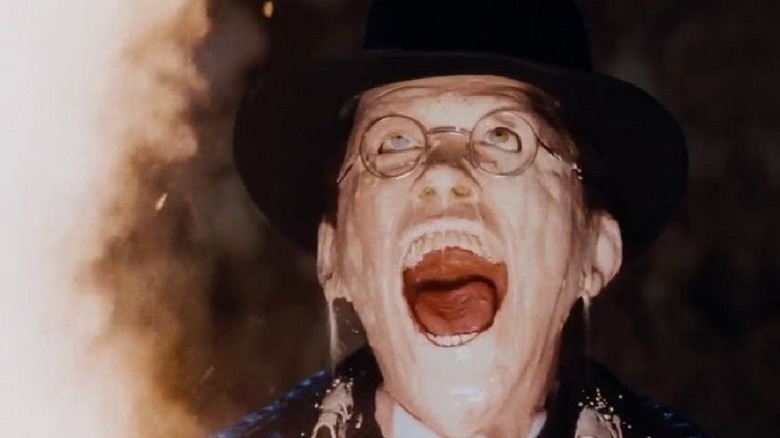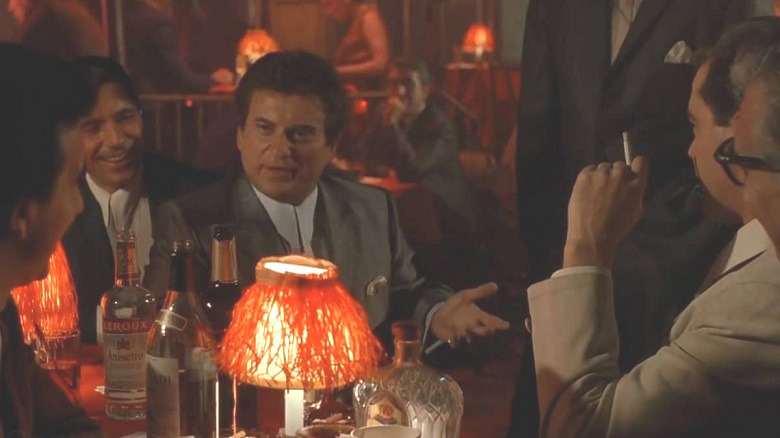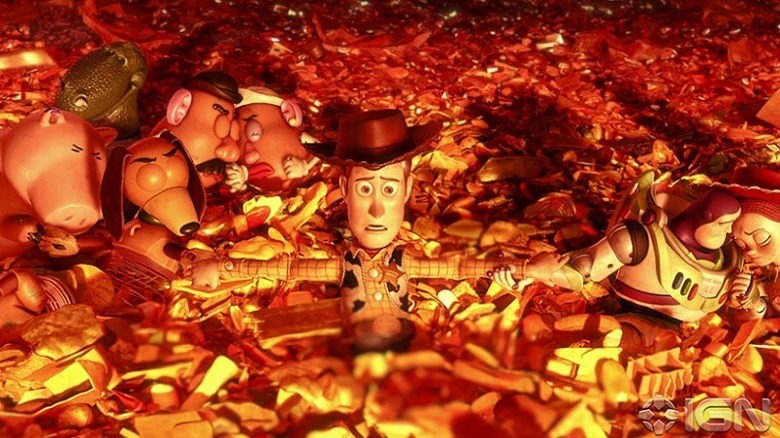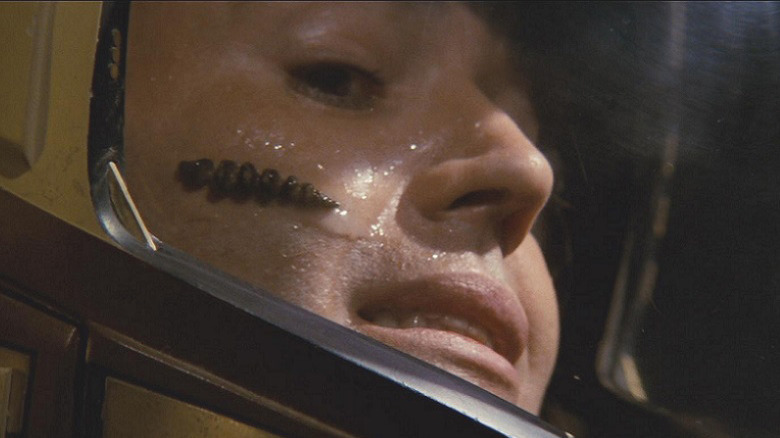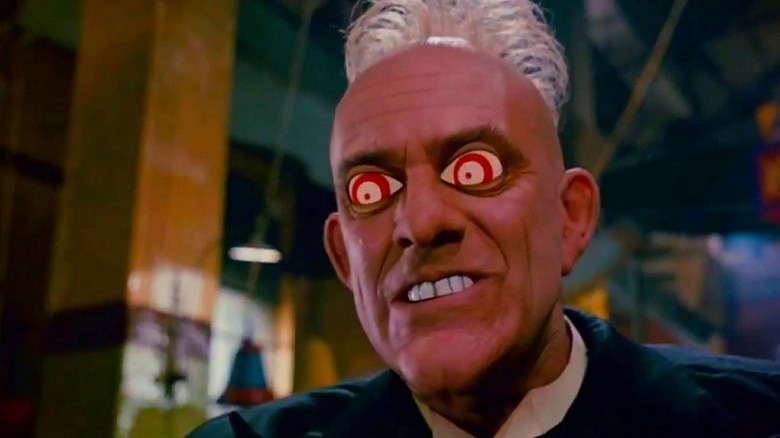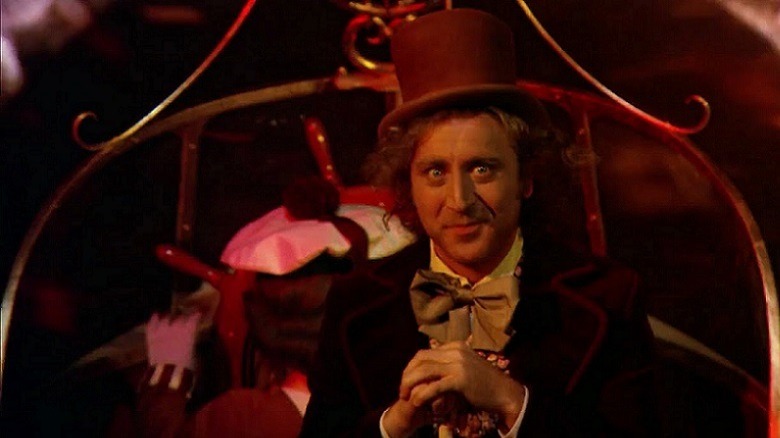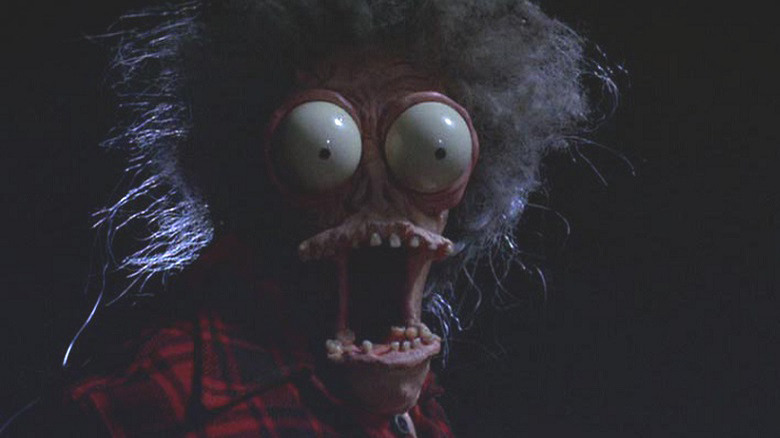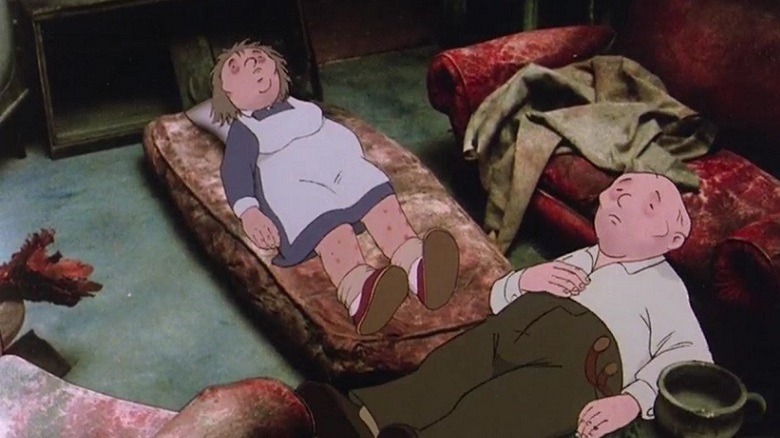The 14 Scariest Moments In Non-Horror Movies
There's a time and a place for scares. We've paid our money and have earned our right to jump out of our seats at least twice during a typical horror movie. But what happens when frightening moments catch us off guard? Even children's films have jump scares; these days, no type of movie is really safe.
Villains who belong in the most X-rated of horrors, yet somehow show up in family-friendly movies. Those "Did you see that?" moments that make you look incredulously at the person sitting next to you. Stunned silence or nervous scared laughter that ripples across a cinema audience, reaching all the way to full-on existential dread that lingers long after the credits have finished rolling. Here are some moments of cinematic horror where you absolutely didn't expect them. So, dim the lights (but not too much — you never know what's hiding in the shadows) and let's go...
Pinocchio — Cigarettes, alcohol, and jackasses
I have the strongest suspicion that Walt Disney hated kids. For all his attempts to entertain them with anthropomorphic mice and elephants with auditory organs capable of self-propulsion, he also spent a great deal of time trying to traumatize them. A demon lurking on top of Bald Mountain. Doe-eyed deer getting gunned down into so much venison. Adorable bloodhounds run over by cars.
But for sheer body horror that rivals anything made by David Cronenberg, it's hard to top the Pleasure Island sequence in "Pinocchio." When the animated mannequin comes across this den of hedonism (featuring delights like scrapping and free booze and cigarettes), his miscreant chum Lampwick lures him down the path of debauchery.
However, it's a trap. Lampwick transforms into a donkey, and Pinocchio's mocking laughter at his pal's fate becomes a rasping hee-haw. In a scene that rivals the metamorphosis from man to wolf in "An American Werewolf in London," we witness Lampwick's full transformation. Hands flatten to hooves, skin stretches to make ears and elongated nose, and his shrieks of terror become panicked braying. One should be at least grateful for the small blessing that Walt was generous enough limit the horror to a silhouette.
The Dark Knight — The Joker's magic trick
Aside from a brief introduction while robbing a Gotham Bank owned by the mob, this is our first proper introduction to Heath Ledger's Joker. He appears, uninvited, in the middle of a mob meeting, placing a pencil vertically on the table, tip pointing towards the ceiling. A roomful of disbelieving and accusing eyes stare back at him, nonplussed. "How about a magic trick?" the Joker asks.
Signaled by his boss, a lackey moves to approach the Joker. In a practiced and elegant single move, Joker pushes the man's head propelled towards the pencil. The dead lackey falls out of sight, pencil presumably embedded well and truly in his eye socket. "Ta-da! It's... gone!"
Bloodless and swift, with the only immediate effect being a roomful of temporarily stunned mobsters and a similarly stunned cinema audience. A microcosm of the Joker in a single part of a single scene: unpredictable and psychopathic. After all, isn't showbiz all about making an entrance?
Jaws — The severed head
I genuinely believe that there are around a dozen different cuts of "Jaws" out in the wild, all of them identical except for that one scene in which a Scuba-gear clad Hooper is examining the remains of Ben Gardner's sunken boat. I think on each of these variants there's a slightly different time delay for when Spielberg reveals the severed head. That's the only possible explanation as to why it gets me every damn time.
I'm not a big fan of jump scares on the whole — they're lazy, crude, and cheap. However, if anybody is going to do a good one, it would have to be Spielberg, wouldn't it? If the unearthly noise of the reveal coupled with the suddenly panicked pace of John Williams' soundtrack doesn't cause an involuntary jump, you're as dead as Ben Gardner.
The thumbnail alone for this entry alone will probably provoke a conditioned response in a great many people who will suddenly find themselves reluctant to take that coastal holiday after all.
Chitty Chitty Bang Bang — The Child Catcher
Oddjob, Jaws, Auric Goldfinger, Francesco Scaramanga, Ernst Stavro Blofeld, and the Child Catcher — all members of that hallowed elite pantheon of movie villains adapted from Ian Fleming books.
Sprite of limb, crooked of nose, and black of heart, the Child Catcher, villain of the proto-"Fast and Furious" movie "Chitty Chitty Bang Bang," is a terrifying presence. But, much like Ash has a certain admiration for the Xenomorph in "Alien," one has to respect the Child Catcher's commitment to the role. With that nom de guerre, there's no messing about. His name is both a title and a mission statement, a role this terrifying lank-haired specter pulls off with aplomb. Neat wheels too: an extravagant fairground carriage that can Optimus-Prime itself into a cage to hold his victims.
Played by dancer Robert Helpmann (who, naturally, was quite caring in real life), the Child Catcher cuts a devilish figure, his black suit and top hat disguised by gaudy ribbons and a colorful coat. Like the Pied Piper, the Child Catcher lures "kiddie-winkies" to their doom, albeit using candies and lollipops. With his penchant for sweets, he's the nemesis of both young children and dentistry; Roald Dahl and Ian Fleming have a lot to apologize for.
Trainspotting — The baby on the ceiling
Choose life. Choose a film. Choose to watch "Trainspotting." Choose to feel sorry for Mark "Rent Boy" Renton's parents as they've forced to lock their heroin-addicted son in his room. Choose to watch Mark go through the horror of withdrawal. Choose to watch Mark subjected to his hallucinations, seeing a distant dead baby on his ceiling.
Choose to remember that this same child died of catastrophic neglect earlier in the movie. Choose to think, "This isn't a horror movie — why is this happening?" Choose to watch the child crawl closer and closer, its tiny, gurgling noises growing louder and louder. Choose to watch the infant stop above Mark, its head swiveling around 180 degrees "Exorcist"-style to face our screaming protagonist. Choose to watch the dead child plummet towards Renton's flailing, terrified form.
Choose to have sleepless nights for the next couple of weeks.
Superman 3 – Vera becomes a cyborg
Purists might argue that the most horrific thing about "Superman 3" is that it was the start of the rot for Christopher Reeve's Man of Steel, but I'll instead highlight a particular moment that gave this writer nightmares for years. As evidenced by the presence of comedic legend Richard Pryor, the humor in "Superman 3" is a lot more pronounced than in the two preceding movies. Whereas the first two "Superman" films have a lighthearted touch and a playful irreverence, this movie feels like a comedy vehicle for Pryor that just happens to feature a blue-suited red-caped Kryptonian as the straight man.
So, a certain moment in the final act comes completely out of the blue. When poor Lex Luthor substitute Ross Webster's supercomputer becomes self-aware, preventing any attempts to deactivate it, Webster's sister, Vera, tries to escape. A flurry of sparks halts her in her tracks, and the computer tractor beams her into the machine's wiry innards.
To young impressionable minds, what follows is as traumatic as that scene in the uncut "Evil Dead". Vera screams as metal panels are welded to her face, arms and hands, the ghastly noise only ceasing when a panel is grafted over her jaw. They open again, transformed into unblinking spheres of silver, and Vera is reduced to a cybernetic extension of the super-computer.
It's okay, though. There's a funny bit where Richard Pryor pretends that he can fly later on, which makes it all better, right?
Raiders of the Lost Ark — The ark opens
From decomposed bodies on spikes to hug-happy mummies, "Raiders of the Lost Ark" already has its fair share of horrific moments, but it's the opening of the Ark that will linger long in the memory. As the spirits loop-de-loop around the room with the giddy enthusiasm of ghosts freshly released from the Ghostbusters' containment unit, Indy screams at Marion to keep her eyes closed. As an audience, we're about to find out why.
The chief Nazi and Gestapo agent Toht go up like they're sponsored by the Yankee Candle company, screaming in agony as the flesh drips from their melting faces like nacho cheese. Rival archaeologist Belloq fares little better, engulfed in flame before doing his best impression of Michael Ironside in "Scanners," exploding into a shower of char-grilled chunks of flesh.
It's a moment scorched onto the retinas of an immeasurable quantity of young minds, who sat in tears or stunned silence as the bombast of John Williams' "The Raiders March" played over the end credits. Child psychologists will struggle with the fallout for years, even the top men. Still, the only thing better than a dead Nazi is a melting Nazi, am I right?
Goodfellas — Tommy DeVito's diatribe
Many groups of friends have somebody like Joe Pesci's Tommy DeVito — someone who's funny and confident, but is plagued by insecurity. However, few of them are as flawed as Tommy; he's also unbalanced, entitled, and possesses a hair trigger temper.
In a film already casually spattered with dark moments, Tommy DeVito's big rant in the restaurant is a standout. He's telling a story that causes the assembled throng to collapse in laughter, and fellow mobster Henry makes the casual remark that DeVito is a funny guy. Tommy's face drops as he demands to know what Henry means. "I'm funny how?" he growls.
The mood and tempo change instantly, the music softening and the tension between the men palpably growing. Tommy's protestations go on uncomfortably long, as a terrified Henry tries to talk his friend down, eventually gathering enough nerve to tell him to go forth and multiply. Tommy smiles a wise-cracking grin, and the tension is released like the air from an over-inflated balloon. He was joking all along. It's just a single scene, but it's a masterclass in storytelling, telling you all you need to know about Tommy. Still, you'd be forgiven for forgetting to breathe during the 90 seconds the scene takes to unfold.
Toy Story 3 — The toys are trapped in the incinerator
It's not even the thought of the hideous fate that's about to befall the beloved "Toy Story" cast – plummeting into an inferno hot enough to ensure that neither plastic, nor voice box, nor thread remains. It's not that it genuinely looks like Pixar's filmmakers are going to kill off characters that we've loved for 15 years. It's not even the impotent horror of watching our heroes, who have fought for so long and so hard, desperately struggling against inevitable doom.
No, it's the weary resignation. The creeping, begrudging acceptance. It's the trembling hands reaching out one another — trotters searching for dinosaur claws, hooves grasping for space suit gauntlets. It's how the characters glance at each other, and then turn eyes forward, their faces despondent, bathed in a fiery glow that edges ever closer, all ready to face it together.
That's the horror.
Star Trek 2: The Wrath of Khan — The Ceti eels
The Star Trek universe is a relatively bloodless one, unless you count the floating lavender globules of Klingon plasma in "Star Trek VI: The Undiscovered Country." So, moments of true horror in Trek are not only few and far between, but memorable when they do rarely appear.
The Ceti Eels in "Star Trek II: The Wrath of Khan" are nightmare fuel, tiny little chitinous creatures that enjoy nothing more than burrowing into ears and wrapping themselves around a lovely cerebral cortex. This has the side effect of making the poor victim susceptible to suggestion, and eventually causes madness and an agonizing death.
Khan uses the eels against two crewmembers of the USS Reliant, Captain Terrell and Commander Pavel Chekov, placing the hungry bugs into their respective helmets before putting them back on. It's excruciating, watching the tiny nightmare crawling along a helpless Chekov's cheek before it slowly crawls across his lobe and into his open ear canal. He's screaming for the entire duration, only silenced when the tiny thing's hugging his brain like a long-lost friend.
Who Framed Roger Rabbit? — Doom reveals himself
Not that it comes as a great surprise given his name, but Judge Doom is thoroughly rotten. Even so, it comes as somewhat of a surprise to learn his true horrific nature — and to see his gruesome visage, which will make you wish you could pop your memories into a convenient tub of Dip.
Watching the toon shoe (God rest his sole) meet his fate in a vat of acid is horrific and upsetting enough, but Doom's eventual unmasking marks him as an outcast from Tex Avery's most terrifying nightmares. After it looks like Doom has been crushed by a steamroller, his flattened form gets up and starts teetering around like a two-dimensional paper doll.
That's when Eddie Valiant realizes that something's up. The Judge reinflates himself (with his fake eyes popping out, because we're not quite terrified enough), and we see Doom's true form: bald head, bulging eyes that literally look like daggers, and a helium-inflected high-pitched maniacal voice. Christopher Lloyd has never been better, more sinister, or scarier. He's a far cry from genial Doc Brown, that's for sure.
Willy Wonka and the Chocolate Factory — The boat trip down the river
Putting aside the very concept of the Oompa-Loompas, who seem to have a well-choreographed dance routine prepared for every form of accident in the chocolate factory — how sinister is that? – no list of unexpected horror moments would be complete without this one. Roald Dahl was equally as complicit as Walt Disney in terrifying young minds — the witches reveal in "The Witches" and the bad giants in "BFG" to name but two — but very few kids' movies have a scene in which a live chicken is decapitated.
Willie Wonka, man-child, sociopathic narcissist, and owner of the titular chocolate factory, takes the children on a boat ride into the center of his operation. What should have been a sedate meander down the river ends up as the child-oriented equivalent of "Apocalypse Now," only rather than meeting Colonel Kurtz at the other end the kids are confronted with a variety of factory rooms that don't even begin to meet health and safety regulations.
As the boat increases in speed, Wonka singing his inane song the whole time, hellish imagery flickers on the walls, including cockroaches, eyeballs, and the aforementioned chicken; it's like something from Bosch's Garden of Earthly Delights, only with more artificial coloring and sweetener. Who would ever have suspected that the river Styx was made of chocolate?
Pee-Wee's Big Adventure — Large Marge
Large Marge riffs off a similar sequence with Dan Aykroyd in "Twilight Zone: The Movie," which came out two years before. However, that was definitely a horror movie. "Pee-Wee's Big Adventure" is, ostensibly, for kids.
Pee-Wee Herman is searching for his bicycle (an act for which nobody could blame him — it's a lovely bicycle) and is forced to hitch a ride on an 18-wheeler that emerges from the nighttime fog. It's here we meet creepy driver Large Marge. She begins telling Pee-Wee about the worst accident she's ever seen. It starts as a spooky story. It culminates with Marge's impression of what the driver's body looked like when they pulled him from the twisted, burning wreck.
Even when you know what's coming, the transformation remains startling. A brief glimpse of a vision from the darkest cartoon ever made, it's a moment guaranteed to elicit a startled squeal from the viewer — usually followed by an embarrassed laugh.
When the Wind Blows — The nuclear apocalypse
In the '80s, we were constantly reminded that nuclear bombs would kill us. Television ads, leaflets pushed through our doors, and every news headline delivered the news. Our entertainment did, too. American adults had "The Day After," a TV movie about a nuclear attack on the US, and the UK had "Threads," a drama that showed the effect of a nuclear strike on Sheffield. But those aired late at night, and were clearly intended for an adult audience.
And then there was "When the Wind Blows," a 1986 animated film that follows an adorable elderly couple, Jim and Hilda, who live in rural England. We see their daily lives as their transistor radio reports on increasing tensions between Russia and the US. Jim and Hilda attempt to build a bomb shelter, and their efforts verge on the comical. Hilda's naivety is particularly adorable; they survived World War II with pluck and stiff British upper lips. Why should World War III be any different?
And then the missiles fly and fall, and we witness the aftermath. The lovely grandparents stagger from their ramshackle shelter into the irradiated smog, drinking contaminated water from their taps. We watch in horror as their gums bleed, their hair falls out, and they start to run out of food, all in the ruins of their once-lovely cottage, which is now engulfed in permanent darkness. Good night, kids! Sleep well.
